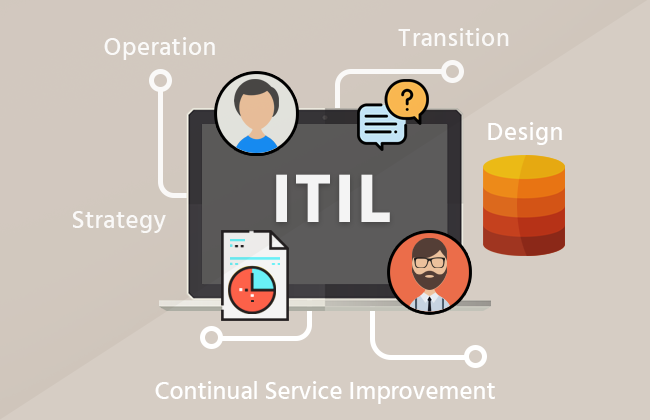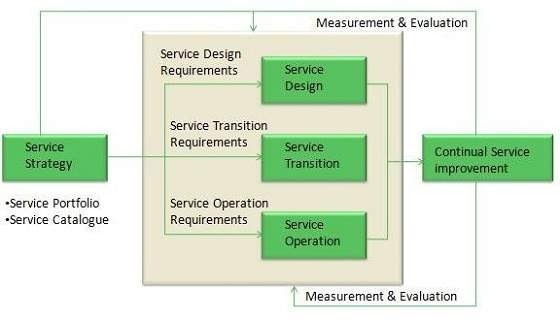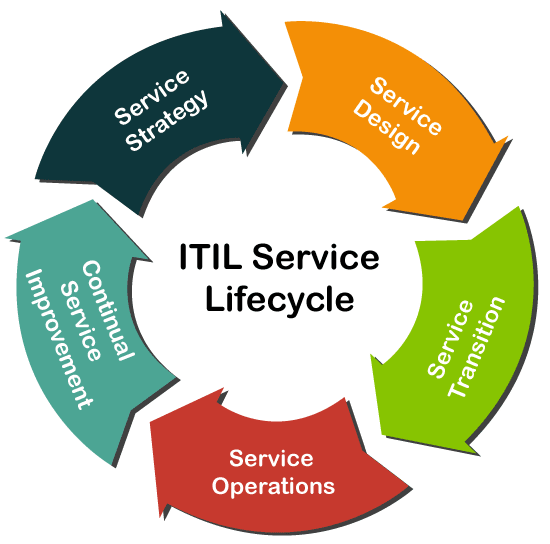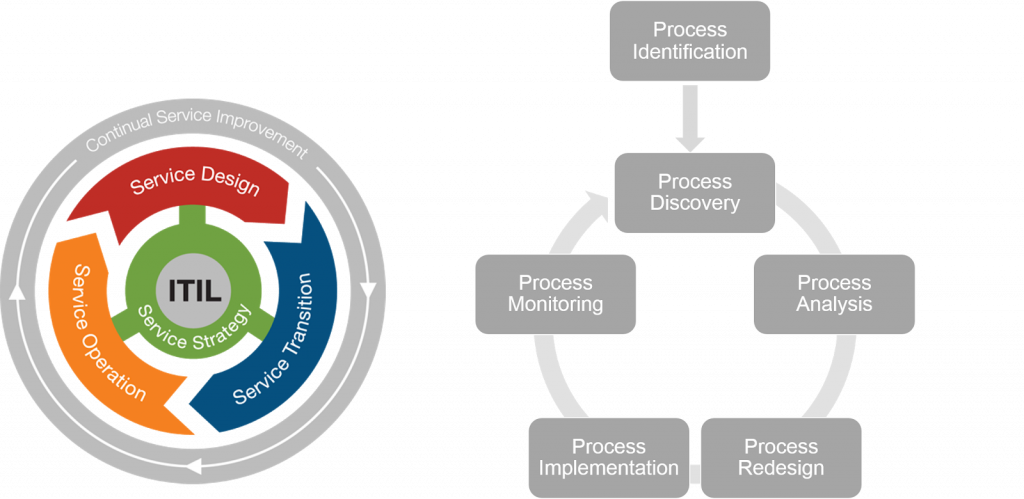
ITIL

- ITIL is a set of guidelines that helps Software professionals in delivering the best IT services. These guidelines are best practices that are gathered, observed, and put together over time to deliver quality IT services. The full form of ITIL is Information Technology Infrastructure Library.
- Popular IT services covered by ITIL are Cloud services, backup, network security, Data processing and storage, managed print services, IT consulting, Help desk support, IOT etc.
Important Terminologies and Definitions used in ITIL
- Roles: are defined as collections of particular responsibilities and privileges. It may be held by an individual or team.
- Service Owner: The entity which is accountable for the overall design, performance, integration, and improvement of a single service.
- Process Owner: Responsible for the overall design, performance, integration, improvement, and management of a single process.
- Product Manager: Accountable for development, performance, and quality check and the improvement of a group of related services.
- Service Manager: Responsible for the development, performance, and improvement of all services in the environment.
- Services: A means of delivering value to customers without the need to specify costs and risks.
- Access : The level and scope of the functionality of a service or data that the user is allowed to use.
- Capabilities: It is specialized skills of an organization apply to resources in order to create value.
- Functions: Self-contained subsets of an organization which is intended to accomplish specific tasks.
- Processes: Structured group of activities designed to achieve a specific objective.
- Resources: They are raw materials that contribute to a service, such as money, equipment, time, and staff.
Features of ITIL
Here are some important features of ITIL
- One language/terminology.
- ITIL is a means to deliver a consistent quality.
- Focus on IT. However, it is just not only suitable for IT.
- Existing activities and how to optimize them.
- Related process and tasks (roles).
Service Lifecycle in ITIL
- The ITIL framework is completely based on the lifecycle of a service. The lifecycle of IT Service Management is also called as a ‘Plan-Do-Check-Act (PDCA)’ or ‘Deming Cycle’. It helps the service providers to achieve a better understanding of its structure. It also defines the process that how the services are started and maintained.The complete framework of ITIL is based on service lifecycle. Each lifecycle defines certain processes for effective service management.

- Service lifecycle helps to amplify the service management approach and to achieve better understanding of its structure. In the coming chapters, we will be discussing all lifecycle individually with their processes and functions.
Processes and Functions
- There are 26 processes and 4 functions in ITIL V3. These processes and functions are discussed in detail with each service lifecycle in further chapters.
Process
- A process defines policies, standards, guidelines, activities, and work instructions. It takes some defined inputs to produce desired results.
Functions
- A function is defined as group of people or tools required to carry out one or more processes and activities.
- The lifecycle of a service in the framework of ITIL is broadly classified into the following five stages:

- Service Strategy
- Service Design
- Service Transition
- Service Operations
- Continual Service Improvement
Each stage in this lifecycle contains the various process of ITIL and all the stages are interconnected. Now, we will learn about each stage of service lifecycle one by one.
Service Strategy
- Service Strategy is the first and initial stage in the lifecycle of the ITIL framework. The main aim of this stage is that it offers a strategy on the basis of the current market scenario and business perspective for the services of IT.
- This stage mainly defines the plans, position, patters, and perspective which are required for a service provider. It establishes the principles and policies which guide the whole lifecycle of IT service.
- Following are the various essential services or processes which comes under the Service Strategy stage:
- Financial Management
- Demand Management
- Service Portfolio Management
- Business Relationship Management
- Strategy Management
Strategy Management:
- The aim of this management process is to define the offerings, rivals, and capabilities of a service provider to develop a strategy to serve customers.
- According to the version 3 (V3) of ITIL, this process includes the following activities for IT services:
- Identification of Opportunities
- Identification of Constraints
- Organizational Positioning
- Planning
- Execution
- Following are the three sub-processes which comes under this management process:
- Strategic Service Assessment
- Service Strategy Definition
- Service Strategy Execution
Financial Management:
- This process helps in determining and controlling all the costs which are associated with the services of an IT organization. It also contains the following three basic activities:
- Accounting
- Charging
- Budgeting
- Following are the four sub-processes which comes under this management process:
- Financial Management Support
- Financial Planning
- Financial Analysis and Reporting
- Service Invoicing
Demand Management
- This management process is critical and most important in this stage. It helps the service providers to understand and predict the customer demand for the IT services. Demand management is a process which also work with the process of Capacity Management. Following are basic objectives of this process:
- This process balances the resources demand and supply.
- It also manages or maintains the quality of service.
- According to the version 3 (V3) of ITIL, this process performs the following 3 activities:
- Analysing current Usage of IT services
- Anticipate the Future Demands for the Services of IT.
- Influencing Consumption by Technical or Financial Means
- Following are the two sub-processes which comes under this management process:
- Demand Prognosis
- Demand Control.
Business Relationship Management
- This management process is responsible for maintaining a positive and good relationship between the service provider and their customers. It also identifies the needs of a customer. And, then ensure that the services are implemented by the service provider to meet those requirements.
- This process has been released as a new process in the ITIL 2011.
- According to the version 3 (V3) of ITIL, this process performs the following various activities:
- This process is used to represent the service provider to the customer in a positive manner.
- This process identifies the business needs of a customer.
- It also acts as a mediator if there is any case of conflicting requirements from the different businesses.
Following are the six sub-processes which comes under this management process:
- Maintain Customer Relationships
- Identify Service Requirements
- Sign up Customers to standard Services
- Customer Satisfaction Survey
- Handle Customer Complaints
- Monitor Customer Complaints.
Service Portfolio Management
- This management process defines the set of customer-oriented services which are provided by a service provider to meet the customer requirements. The primary goal of this process is to maintain the service portfolio.
Following are the three types of services under this management process:
1. Live Services 2. Retired Services 3. Service Pipeline.
Following are the three sub-processes which comes under this management process:
- Define and Analyse the new services or changed services of IT.
- Approve the changes or new IT services
- Service Portfolio review.

Service Design
- It is the second phase or a stage in the lifecycle of a service in the framework of ITIL. This stage provides the blueprint for the IT services. The main goal of this stage is to design the new IT services. We can also change the existing services in this stage.
Following are the various essential services or processes which comes under the Service Design stage:
- Service Level Management
- Capacity Management
- Availability Management
- Risk Management
- Service Continuity Management
- Service Catalogue Management
- Information Security Management
- Supplier Management
- Compliance Management
- Architecture Management
Service Level Management
- In this process, the Service Level Manager is the process owner. This management is fully redesigned in the ITIL 2011.
- Service Level Management deals with the following two different types of agreements:
- Operational Level Agreement
- Service Level Agreement
According to the version 3 (V3) of ITIL, this process performs the following activities:
- It manages and reviews all the IT services to match service Level Agreements.
- It determines, negotiates, and agrees on the requirements for the new or changed IT services.
Following are the four sub-processes which comes under this management process:
- Maintenance of SLM framework
- Identifying the requirements of services
- Agreements sign-off and activation of the IT services
- Service level Monitoring and Reporting.
Capacity Management
- This management process is accountable for ensuring that the capacity of the IT service can meet the agreed capacity in a cost-effective and timely manner. This management process is also working with other processes of ITIL for accessing the current infrastructure of IT.
According to the version 3 (V3) of ITIL, this process performs the following activities:
- It manages the performance of the resources so that the IT services can easily meet their SLA targets.
- It creates and maintains the capacity plan which aligns with the strategic plan of an organization.
- It reviews the performance of a service and the capacity of current service periodically.
- It understands the current and future demands of customer for the resources of IT.
Following are the four sub-processes which comes under this management process:
- Business Capacity Management
- Service Capacity Management
- Component Capacity Management
- Capacity Management Reporting
Availability Management
- In this process, the Availability Manager is the owner. This management process has a responsibility to ensure that the services of IT meet the agreed availability goals. This process also confirms that the services which are new or changed does not affect the existing services.
- It is used for defining, planning, and analyzing all the availability aspects of the services of IT.
According to the version 3 (V3) of ITIL, this process contains the following two activities:
- Reactive Activity
- Proactive Activity
Following are the four sub-processes which comes under this management process:
- Design the IT services for availability
- Availability Testing
- Availability Monitoring and Reporting
Risk Management
- In this process, the Risk Manager is the owner. This management process allows the risk manager to check, assess, and control the business risks. If any risk is identified in the process of business, the risk of that entry is created in the ITIL Risk Register.
According to the version 3 (V3) of ITIL, this process performs the following activities in the given order:
- It identifies the threats.
- It finds the probability and impact of risk.
- It checks the way for reducing those risks.
- It always monitors the risk factors.
Following are the four sub-processes which comes under the Risk process:
- Risk Management Support
- Impact on business and Risk analysis
- Monitoring the Risks.
- Assessment of Required Risk Mitigation
Service Catalogue Management (SCM)
- In this process, the Service Catalogue Manager is the owner. This management process allows the Catalogue Manager to give the huge information about all the other management processes.
- It contains the services in the service operation phase which are presently active.
- It is a process which certifies that the service catalogue is maintained, produced, and contains all the accurate information for all the operational IT services.
Following are the two types or aspects of service catalogue in ITIL framework:
- BSC or Business Service Catalogue
- TSC or Technical Service Catalogue
Under this management process, no sub-process is specified or defined.
Service Continuity Management
- In this process, the IT Service Continuity Manager is specified as the owner. It allows the continuity manager to maintain the risks which could impact on the service of IT.
- This process is bound with other processes of ITIL such as capacity and availability management to access and plan the resources which are needed to manage the desired service level.
The ITSCM consists of the following four activities or stages:
- Initiation
- Requirements and Strategy
- Implementation
- Ongoing Operation
Information Security Management
- In this process, the Information Security Manager is specified as the owner. The main aim of this management process is to verify the confidentiality, integrity, and availability of the data, information, and services of an IT organization.
- The main objective of this process is to control the access of information in the organizations.
According to the version 3 (V3) of ITIL, this process performs the following four activities:
1. Plan 2. Implement 3. Evaluation 4. Maintain
According to the version 3 (V3) of ITIL, following are the four sub-processes which comes under this management process:
- Design of Security controls
- Validation and Testing of Security
- Management of Security Incidents
- Security Review
Supplier Management
- In this process, the Supplier Manager plays a role as an owner. The supplier manager is responsible to verify that all the suppliers meet their contractual commitments.
- It also works with the Financial and knowledge management, which helps in selecting the suppliers on the basis of previous knowledge.
Following are the various activities which are involved in this process:
- It manages the sub-contracted suppliers.
- It manages the relationship with the suppliers.
- It helps in implementing the supplier policy.
- It also manages the supplier policy and supports the SCMIS.
- It also manages or maintains the performance of the suppliers.
According to the version 3 (V3) of ITIL, following are the six sub-processes which comes under this management process:
- Provide the Framework of Supplier Management
- Evaluation and selection of new contracts and suppliers
- Establish the new contracts and suppliers
- Process the standard orders
- Contract and Supplier Review
- Contract Renewal or Termination.
Compliance Management
- In this process, the Compliance Manager plays a role as an owner. This management process allows the compliance manager to check and address all the issues which are associated with regulatory and non-regulatory compliances.
- Under this compliance management process, no sub-process is specified or defined.
- Here, the role of Compliance Manager is to certify that the guidelines, legal requirements, and standards are being followed properly or not. This manager works in parallel with the following three managers:
- Information Security Manager
- Financial Manager
- Service Design Manager.
Architecture Management
- In this process, the Enterprise Architect plays a role as an owner. The main aim of Enterprise Architect is to maintain and manage the architecture of the Enterprise.
- This management process helps the Enterprise Architect by verifying that all the deployed services and products operate according to the specified architecture baseline in the Enterprise.
- This process also defines and manages a baseline for the future technological development.
- Under this Architecture management process, no sub-process is specified or defined.
Service Transition
- Service Transition is the third stage in the lifecycle of ITIL Management Framework.
- The main goal of this stage is to build, test, and develop the new or modified services of IT. This stage of service lifecycle manages the risks to the existing services. It also certifies that the value of a business is obtained.
- This stage also makes sure that the new and changed IT services meet the expectation of the business as defined in the previous two stages of service strategy and service design in the lifecycle.
It can also easily manage or maintains the transition of new or modified IT services from the Service Design stage to Service Operation stage.
There are following various essential services or processes which comes under the Service Transition stage:
- Change Management
- Release and Deployment Management
- Service Asset and Configuration Management
- Knowledge Management
- Project Management (Transition Planning and Support)
- Service Validation and Testing
- Change Evaluation
Change Management
- In this process, the Change Manager plays a role as an owner. The Change Manager controls or manages the service lifecycle of all changes. It also allows the change Manager to implement all the essential changes to be required with the less disruption of IT services.
- This management process also allows its owner to recognize and stop any unintended change activity. Actually, this management process is tightly bound with the process “Service Asset and Configuration Management”.
Following are the three types of changes which are defined by the ITIL.
- Normal Change
- Standard Change
- Emergency Change
All these changes are also known as the Change Models.
According to the version 3 (V3) of ITIL, following are the eleven sub-processes which comes under this Change management process:
- Change Management Support
- RFC (Request for Change) Logging and Review
- Change Assessment by the Owner (Change Manager)
- Assess and Implement the Emergency Changes
- Assessment of change Proposals
- Change Scheduling and Planning
- Change Assessment by the CAB
- Change Development Authorization
- Implementation or Deployment of Change
- Minor change Deployment
- Post Implementation Review and change closure
Release and Deployment Management
- In this process, the Release Manager plays a role as an owner. Sometimes, this process is also known as the ‘ITIL Release Management Process’.
- This process allows the Release Manager for managing, planning, and controlling the updates & releases of IT services to the real environment.
Following are the three types of releases which are defined by the ITIL.
- Minor release
- Major Release
- Emergency Release
According to the version 3 (V3) of ITIL, following are the six sub-processes which comes under this Change management process:
- Release Management Support
- Release Planning
- Release build
- Release Deployment
- Early Life Support
- Release Closure
Service Asset and Configuration Management
- In this process, the Configuration Manager plays a role as an owner.
This management process is a combination of two implicit processes:
- Asset Management
- Configuration Management
- The aim of this management process is to manage the information about the (CIs) Configuration Items which are needed to deliver the services of IT. It contains information about versions, baselines, and the relationships between assets.
According to the version 3 (V3) of ITIL, following are the five sub-processes which comes under this Change management process:
- Planning and Management
- Configuration Control and Identification
- Status Accounting and reporting
- Audit and Verification
- Manage the Information
Knowledge Management
- In this process, the Knowledge Manager plays a role as an owner. This management process helps the Knowledge Manager by analyzing, storing and sharing the knowledge and the data or information in an entire IT organization.
- Under this Knowledge Management Process, no sub-process is specified or defined.
Transition Planning and Support
- In this process, the Project Manager plays a role as an owner. This management process manages the service transition projects. Sometimes, this process is also known as the Project Management Process.
- In this process, the project manager is accountable for planning and coordinating resources to deploy IT services within time, cost, and quality estimates.
According to the version 3 (V3) of ITIL, this process performs the following activities:
- It manages the issues and risks.
- It defines the tasks and activities which are to be performed by the separate processes.
- It makes a group with the same type of releases.
- It manages each individual deployment as a separate project.
According to the version 3 (V3) of ITIL, following are the four sub-processes which comes under this Project management process:
- Initiate the Project
- Planning and Coordination of a Project
- Project Control
- Project Communication and Reporting
Service Validation and Testing
- In this process, the Test Manager plays a role as an owner. The main goal of this management process is that it verifies whether the deployed releases and the resulting IT service meets the customer expectations.
- It also checks whether the operations of IT are able to support the new IT services after the deployment. This process allows the Test Manager to remove or delete the errors which are observed at the first phase of the service operation stage in the lifecycle.
- It provides the quality assurance for both the services and components. It also identifies the risks, errors and issues, and then they are eliminated through this current stage.
- This management process has been released in the version 3 of ITIL as a new process.
- Following are the various activities which are performed under this process:
- Validation and Test Management
- Planning and Design
- Verification of Test Plan and Design
- Preparation of the Test Environment
- Testing
- Evaluate Exit Criteria and Report
- Clean up and closure
According to the version 3 (V3) of ITIL, following are the four sub-processes which comes under this management process:
- Test Model Definition
- Release Component Acquisition
- Release Test
- Service Acceptance Testing
Change Evaluation
- In this process, the Change Manager plays a role as an owner. The goal of this management process is to avoid the risks which are associated with the major changes for reducing the chances of failures.
- This process is started and controlled by the change management and performed by the change manager.
- Following are the various activities which are performed under this process:
- It can easily identify the risks.
- It evaluates the effects of a change.
According to the version 3 (V3) of ITIL, following are the four sub-processes which comes under this management process:
- Change the Evaluation prior to Planning
- Change the Evaluation prior to Build
- Change the Evaluation prior to Deployment
- Change the Evaluation prior after Deployment
Service Operations
- Service Operations is the fourth stage in the lifecycle of ITIL. This stage provides the guidelines about how to maintain and manage the stability in services of IT, which helps in achieving the agreed level targets of service delivery.
- This stage is also responsible for monitoring the services of IT and fulfilling the requests. In this stage, all the plans of transition and design are measured and executed for the actual efficiency. It is also responsible for resolving the incidents and carrying out the operational tasks.
There are following various essential services or processes which comes under the stage of Service Operations:
- Event Management
- Access Management
- Problem Management
- Incident Management
- Application Management
- Technical Management
Event Management
- In this process, the IT Operations Manager plays a role as an owner. The main goal of this management process is to make sure that the services of IT and CIs are constantly monitored. It also helps in categorizing the events so that appropriate action can be taken if needed.
- In this Management process, the process owner takes all the responsibilities of processes and functions for the multiple service operations.
Following are the various purposes of Event Management Process:
- It allows the IT Operations Manager to decide the appropriate action for the events.
- It also provides the trigger for the execution of management activities of many services.
- It helps in providing the basis for service assurance and service improvement.
The Event Monitoring Tools are divided into two types, which are defined by the Version 3 (V3) of ITIL:
- Active Monitoring Tool
- Passive Monitoring Tool
Following are the three types of events which are defined by the ITIL:
- Warning
- Informational
- Exception
According to the version 3 (V3) of ITIL, following are the four sub-processes which comes under this management process:
- Event Monitoring and Notification
- First level Correlation and Event Filtering
- Second level Correlation and Response Selection
- Event Review and Closure.
Access Management
- In this process, the Access Manager plays a role as an owner. This type of Management process is also sometimes called as the ‘Identity Management’ or ‘Rights Management’.
- The role of a process manager is to provide the rights to use the services for authorized users.
- In this Management process, the owner of a process follows those policies and guidelines which are defined by the (ISM) ‘Information Security Management‘.
Following are the six activities which come under this management process and are followed sequentially:
- Request Access
- Verification
- Providing Rights
- Monitoring or Observing the Identity Status
- Logging and Tracking Status
- Restricting or Removing Rights
According to the version 3 (V3) of ITIL, following are the two sub-processes which comes under this management process:
- Maintenance of Catalogue of User Roles and Access profiles
- Processing of User Access Requests.
Problem Management
- In this process, the Problem Manager plays a role as an owner. The main goal of this management process is to maintain or manage the life cycle of all the problems which happen in the services of IT. In the ITIL Framework, the problem is referred to as “an unknown cause or event of one or more incident“.
- It helps in finding the root cause of the problem. It also helps in maintaining the information about the problems.
- Following are the ten activities which come under this management process and are followed sequentially. These ten activities are also called as a lifecycle of Problem Management:
- Problem Detection
- Problem Logging
- Categorization of a Problem
- Prioritization of a Problem
- Investigation and Diagnosis of a Problem
- Identify Workaround
- Raising a Known Error Record
- Resolution of a Problem
- Problem Closure
- Major Problem Review
Incident Management
- In this process, the Incident Manager plays a role as an owner. The main goal of this management process is to maintain or manage the life cycle of all the incidents which happen in the services of IT.
- An incident is a term which is defined as the failure of any Configuration Item (CI) or reduction in the quality of services of IT.
- This management process maintains the satisfaction of users by managing the qualities of IT service. It increases the visibility of incidents.
According to the version 3 (V3) of ITIL, following are the nine sub-processes which comes under this management process:
- Incident Management Support
- Incident Logging and Categorization
- Pro-active User Information
- First Level Support for Immediate Incident Resolution
- Second Level Support for Incident Resolution
- Handling of Major Incidents
- Incident Monitoring and Escalation
- Closure and Evaluation of Incident
- Management Reporting of Incident
Application Management
- In this function, the Application Analyst plays a role as an owner.
- This management function maintains or improves the applications throughout the entire service lifecycle. This function plays an important and essential role in the applications and system management.
- Under this management function, no sub-process is specified or defined. But, this management function into the following six activities or stages:
1. Define 2. Design 3. Build 4. Deploy 5. Operate 6. Optimize
Technical Management
- In this function, the Technical Analyst plays a role as an owner. This function acts as standalone in the IT organizations, which basically consists of technical people and teams. The main goal of this function is to provide or offer the technical expertise. And, it also supports for maintaining or managing of IT infrastructure throughout the entire lifecycle of a service.
- The role of the Technical Analyst is to develop the skills, which are required to
operate the day-to-day operations of IT infrastructure. Under this management function, no sub-process is specified or defined.
Continual Service Improvement
- It is the fifth stage in the lifecycle of ITIL service. This stage helps to identify and implement strategies, which is used for providing better services in future.
Following are the various objectives or goals under this CSI:
- It improves the quality services by learning from the past failures.
- It also helps in analyzing and reviewing the improvement opportunities in every phase of the service lifecycle.
- It also evaluates the service level achievement results.
- It also describes the best guidelines to achieve the large-scale improvements in the quality of service.
- It also helps in describing the concept of KPI, which is a process metrics-driven for evaluating and reviewing the performance of the services.
There are following various essential services or processes which comes under the stage of CSI:
- Service Review
- Process Evaluation
- Definition of CSI Initiatives
- Monitoring of CSI Initiatives
Advantages of ITIL
Here, are pros/benefits of using ITIL services
- Increase customer satisfaction
- Improve service availability
- Financial management
- Allows you to improve the decision-making process
- Helps you to control infrastructure services
- Helps to create a clear structure of an organization
Application of ITIL
Here, are important areas where ITIL plays an effective
- IT and business strategic planning
- Implementing continuous improvement
- Obtaining and retaining the right resources and skillsets
- Reducing total cost and overall cost of ownership
- Demonstrating the business value to IT
- Helps you to measure IT organization effectiveness and efficiency






